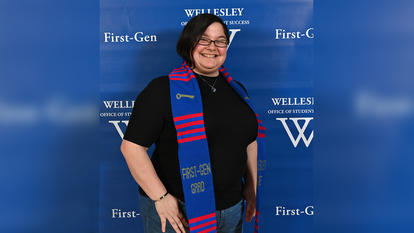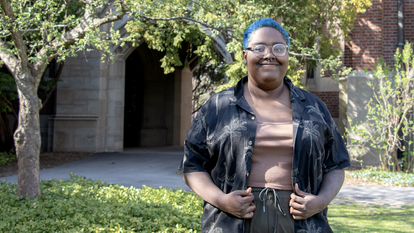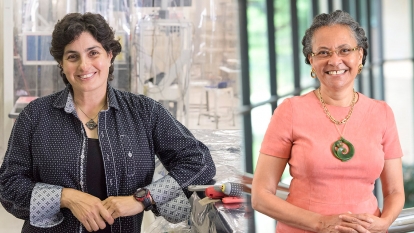2020 Alumnae Achievement Awards
Wellesley’s highest honor is given annually to graduates of distinction who through their achievements have brought honor to themselves and the College. This year’s recipients are Joan Wallace-Benjamin ’75, M. Darby Dyar ’80, and Kimberly Dozier ’87. In lieu of an in-person awards ceremony, the recipients will participate in a virtual conversation with President Paula A. Johnson on Dec. 3 at 7 p.m. ET and Zoom class visits with students.
This is an excerpt from an article that appears in the fall 2020 issue of “Wellesley” magazine. Read the full story on the “Wellesley” magazine website, or linked in the excerpts below.

Joan Wallace-Benjamin ’75
Among the many highlights of her 37-year career as a nonprofit executive, one was particularly resonant for Joan Wallace-Benjamin ’75 during the summer of 2020. For weeks, the country’s attention had been riveted on protests calling for racial justice, and the turmoil reminded her of a similar moment when she was president and CEO of the Urban League of Eastern Massachusetts, a 100-year-old nonprofit aimed at improving the lives of urban residents, particularly people of color.
It was the spring of 1992, and Los Angeles was aflame following the acquittal of police officers involved in the beating of Rodney King, a Black man. Meanwhile, in Boston, Wallace-Benjamin and two other community leaders held a press conference before a packed high school gymnasium to release a list of actions civic leaders could take to ease simmering racial tensions in their own city. “Just as an advocacy move, it was brilliant,” she remembers. “It hit all the right notes at all the right times.”
The list, dubbed “The Ten Demandments,” called for the appointment of an African American district attorney and the establishment of a civilian review board for the Boston Police Department. “We weren’t asking for crazy things,” Wallace-Benjamin says. “We were asking for things that had been on the drawing board but that languished month after month. We used the concern around the incendiary nature of this issue to move it.”
“It was the first time in my career that funders called and said, ‘I have to give you money. How much do you need?’” she says.
It might have been the first time someone volunteered to write her a blank check, but it was far from the only time Wallace-Benjamin used a masterstroke to advance an organization she served. Her transformative leadership has been a common thread running through her management of a variety of organizations that serve vulnerable children and marginalized communities—including Head Start, the Boys & Girls Clubs, and the Home for Little Wanderers.
Keep reading about Joan Wallace-Benjamin ’75.

Darby Dyar ’80
In 1998, Darby Dyar ’80 was at a major crossroads in her life. A rising star in geology and minerology since earning her Ph.D. in geochemistry from MIT in 1985, she was on the verge of earning tenure at West Chester University outside Philadelphia. But she had two small kids, her then-husband was tenured at Amherst College, and she was exhausted from commuting 600 miles most weeks for the previous five years. So when Mount Holyoke College offered her a visiting position in its astronomy department, she didn’t think twice—she moved to the Pioneer Valley in Western Massachusetts.
It was an easy and obvious decision for Dyar, but many of her colleagues were baffled. “There were a lot of people who thought that my career was over when I came to Mount Holyoke. You know, I came from the university environment. They said, ‘Oh, the teaching load’s going to kill you. You won’t have graduate students. You won’t get anything done.’ How wrong they were,’” Dyar says.
Since moving to Mount Holyoke, where Dyar now chairs the astronomy department, she has been a prolific researcher, and her subjects have been wide-ranging, literally spanning the solar system. She helped build a component of the Mars rover Curiosity’s ChemCam instrument and spent six years leading the Mars Science Laboratory mission’s geology science theme group. She is currently the No. 2 scientist on proposed mission to send an orbiter to Venus in 2026, which, if funded by NASA next year, will use a near-infrared spectrometer to determine the composition of Venus’s surface and offer clues about the planet’s past. She is one of a few select researchers who will study pristine lunar samples from the Apollo missions that have been hermetically sealed since they were collected on the Moon. She has also written nearly 300 papers, many with her undergraduate students as coauthors (and in a few cases, first authors), and has received more than $12 million in grants from NASA and the National Science Foundation.
But looking back on her career so far, Dyar says that the thing that she values the most is what naysayers warned her about back in 1998: the time she spends with her undergraduate students. “To me, the most important, lasting contribution is people. And so it’s the students that I’ve mentored that will be the thing I remember,” she says. They will remember her, too. Student testimonials about Dyar for Mount Holyoke’s Meribeth E. Cameron Faculty Award for Scholarship, which she received in 2010, include: “Darby has undoubtedly been [the] single most influential person in my Mount Holyoke experience,” and “Darby knows how to help people succeed in their dreams, not just pursue them.”
Keep reading about Darby Dyar ’80.

Kimberly Dozier ’87
Out of decades of reporting in the Middle East, there are some trips Kimberly Dozier ’87 will never forget. In the fall of 2001, she entered Afghanistan from Pakistan, driven by an official driver of the Taliban.
It was after the deadly Sept. 11 attacks as Kabul fell to Northern Alliance forces that November. For Dozier, a CBS News correspondent, being on the ground was the only way to adequately understand and explain what was happening in the country to an American audience.
After Dozier and her driver got through an initial checkpoint at the Khyber Pass, Dozier says, he “took me to a local hotel, and locked me in, telling me not to answer the door to anyone but [him].” Afghan men knocked on her door all night, and her driver returned at 5 a.m., urging her to leave quickly. She put on a veil, and the two of them got into a taxi. When they reached the next Taliban checkpoint, the driver said something to the taxi driver, who floored it.
“The Taliban on our side of the road raised their guns but were too slow,” she says. Their shouts faded as the taxi sped through the mountains and eventually made it to Kabul.
Dozier was taken to a Taliban safehouse, where she stayed for several weeks. She later learned that a group of journalists who left later that morning to head into Kabul were brutally attacked and killed by the Taliban. It wouldn’t be the last time she’d narrowly escape death.
“She was first out there, tenacious, fearless,” says Janet Leissner, who was then the CBS News Washington Bureau chief. “Fearless” is the word legendary CBS journalist Dan Rather has also used to describe Dozier.
Keep reading about Kimberly Dozier ’87.



